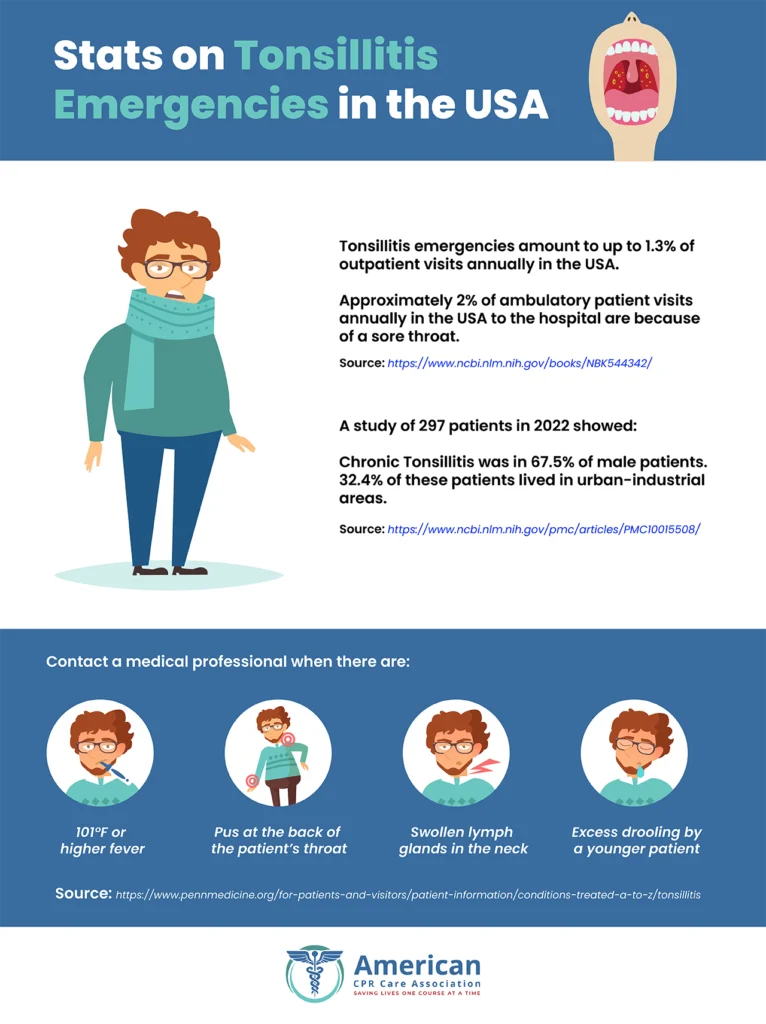
Last Updated On: septiembre 23, 2024
Have you ever had a sore throat that made it difficult to swallow or talk? This might be due to a condition called tonsillitis, where the tonsils in the back of your throat become inflamed. Tonsillitis can be caused by different things, like viruses, bacteria, or allergies. But don’t worry, there are some simple first-aid steps you can take at home to relieve the symptoms.
At the American CPR Care Association, we offer first aid courses that can teach you how to recognize and respond to medical emergencies. Being first aid certified can help you provide quick and effective care in case of an emergency.

Sometimes, tonsillitis can be a recurring problem for some people. If you have frequent episodes of tonsillitis, your doctor might suggest removing your tonsils. This procedure, known as a tonsillectomy, involves removing the tonsils from the back of your throat. Tonsillectomy is usually only recommended for people who have frequent episodes of tonsillitis that don’t respond to other treatments.
Here are some first-aid steps you can take at home to relieve the symptoms of tonsillitis:
Gargle with warm salt water to reduce the pain and inflammation caused by tonsillitis. Mix a teaspoon of salt in warm water and gargle with it several times a day. This can help reduce swelling and ease the pain in your throat.
Drinking warm fluids like tea or soup can also help soothe your throat and provide relief. Warm fluids can help loosen mucus and reduce inflammation in your tonsils. Be sure to avoid cold drinks and foods, as they can irritate your throat and make your symptoms worse.
Over-the-counter pain relievers like ibuprofen or acetaminophen can also help reduce the pain and fever associated with tonsillitis. These medications can help you feel more comfortable and get better rest. Be sure to follow the dosage instructions on the label and consult with your doctor if you have any concerns or questions.
Finally, getting plenty of rest is important when you have tonsillitis. Resting your body can help it fight off the infection and reduce your symptoms. Make sure to stay home and try to avoid activities that require a lot of physical exertion.
Remember, these first aid-steps can help relieve the symptoms of tonsillitis, but they are not a substitute for medical treatment. If your symptoms persist or worsen, or if you have difficulty breathing, seek medical attention right away.
Home remedies are effective in treating the majority of tonsillitis cases. However, if your symptoms persist for over a week, you should see a doctor. You should also see a doctor if you have trouble breathing, severe pain, or develop a high fever.
Being first aid certified can help you respond quickly and effectively in case of an emergency. ACCA offers first aid courses that can teach life-saving skills like CPR, how to use an AED, and how to respond to different medical emergencies.
The ACCA first aid course is an essential training program that equips individuals with life-saving skills and knowledge. Its simplicity and effectiveness make it accessible and easy to understand for people of all ages, from teenagers to adults. By taking this course, individuals can develop confidence and the ability to provide prompt and appropriate care in emergencies, which can potentially save lives.
Tonsillitis can be a painful and uncomfortable condition, but there are simple first aid steps you can take at home to relieve the symptoms. Being first-aid certified with ACCA can help you provide fast and effective care in case of an emergency.

